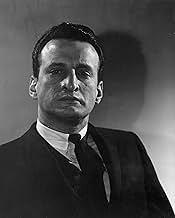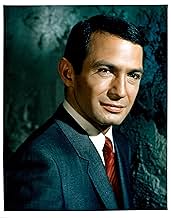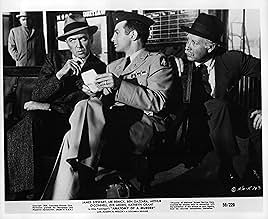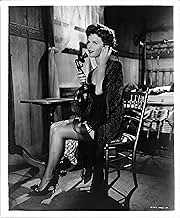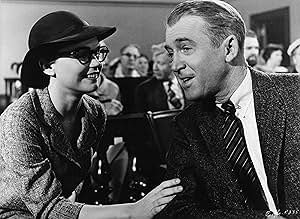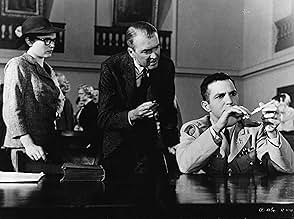Jugé pour meurtre, Frederick Manion avoue avoir souffert de folie passagère après que la victime ait violé sa femme.Jugé pour meurtre, Frederick Manion avoue avoir souffert de folie passagère après que la victime ait violé sa femme.Jugé pour meurtre, Frederick Manion avoue avoir souffert de folie passagère après que la victime ait violé sa femme.
- Réalisation
- Scénario
- Casting principal
- Nommé pour 7 Oscars
- 10 victoires et 18 nominations au total
Avis à la une
I have tried more cases than I can remember - hundreds. This movie, more than any other, comes closet to real life.
In criminal cases., the first and most important thing is - the phone call. That's right, getting the case.
Next comes the 'talk.' An attorney has to inform the client of the possible outcomes given the facts. In Anatomy of a Murder, the main facts are 'undisputed', that is, there is no doubt that the defendant killed the victim.
Given that fact, there are only so many possible defenses - and so Jimmy Stewart, in one of the best performances of his career, relates those defenses to Ben Gazzara, in one of his best performances.
Along the way, we are treated to George C. Scott's premiere performance on screen - and it is is magnificent.
Did I mention how incredible and sexy and vulnerable Lee Remick is?
And the rest of the cast is also as good as it gets.
And then there's the Duke Ellington score (he won a Grammy) and the Wendell Mayes screenplay and the B/W cinematography by Sam Leavitt (The Defiant Ones (Oscar-winner), A Star is Born (1954)).
Watch this movie to see how to make a crime drama. There is nothing as good as it is - nothing.
... since part of the allure is the mystery as to whether or not a true murder has been committed in the first place. There is a killing - but is it murder? That is what this courtroom drama is trying to determine.
Paul Biegler (James Stewart) is a country lawyer in Michigan who was once the local DA but must have lost reelection at some point. He seems to consider himself pseudo-retired, as he stays in just enough contract work to finance his true love - fishing. But then a lieutenant in the army (Ben Gazzara as Fred Manion) kills the man who raped his wife (Lee Remick as Laura Manion), is charged with murder, and Biegler has a big case on his hands.
Manion is a bit shifty - At first claiming he has the "unwritten law" on his side. But then when Biegler tells him there really is no such thing, Manion adjusts his story such that temporary insanity could be a plausible defense.
The truth is, it never is clear which was true - Did Manion truly temporarily lose it when he saw his wife brutalized by a rapist, or did Laura Manion get cold busted by her husband stepping out with another man with the result being that Lt. Manion lost his temper and killed the other man? Gazzara plays his part as arrogant and Remick plays her part as flirty, each shooting the other looks at various points that indicate they are keeping at least part of the truth to themselves. What keeps it interesting are the characters, the emphasis on the legal process, and the question I just posed that hangs over the entire proceedings. Although everyone is good, the judge is an absolute understated scream. You can tell he doesn't like having this high profile case in his courtroom, that like Biegler he'd rather be fishing, but he has a job to do and he'll do it fairly. Joseph Welch played the part of the judge, and the fact that he was actually an attorney gives the performance the needed authenticity.
James Stewart was supposed to star in "North By Northwest" in 1959, but Hitchcock was angry at him because Vertigo had been a commercial failure, calling Stewart too old. He then dumped Stewart for Cary Grant so that Stewart was available to do this film. In the end, everything worked out. All three films are now recognized classics, and I can't see anybody but Stewart with his folksy charm playing the lead in this film.
Paul Biegler (James Stewart) is a country lawyer in Michigan who was once the local DA but must have lost reelection at some point. He seems to consider himself pseudo-retired, as he stays in just enough contract work to finance his true love - fishing. But then a lieutenant in the army (Ben Gazzara as Fred Manion) kills the man who raped his wife (Lee Remick as Laura Manion), is charged with murder, and Biegler has a big case on his hands.
Manion is a bit shifty - At first claiming he has the "unwritten law" on his side. But then when Biegler tells him there really is no such thing, Manion adjusts his story such that temporary insanity could be a plausible defense.
The truth is, it never is clear which was true - Did Manion truly temporarily lose it when he saw his wife brutalized by a rapist, or did Laura Manion get cold busted by her husband stepping out with another man with the result being that Lt. Manion lost his temper and killed the other man? Gazzara plays his part as arrogant and Remick plays her part as flirty, each shooting the other looks at various points that indicate they are keeping at least part of the truth to themselves. What keeps it interesting are the characters, the emphasis on the legal process, and the question I just posed that hangs over the entire proceedings. Although everyone is good, the judge is an absolute understated scream. You can tell he doesn't like having this high profile case in his courtroom, that like Biegler he'd rather be fishing, but he has a job to do and he'll do it fairly. Joseph Welch played the part of the judge, and the fact that he was actually an attorney gives the performance the needed authenticity.
James Stewart was supposed to star in "North By Northwest" in 1959, but Hitchcock was angry at him because Vertigo had been a commercial failure, calling Stewart too old. He then dumped Stewart for Cary Grant so that Stewart was available to do this film. In the end, everything worked out. All three films are now recognized classics, and I can't see anybody but Stewart with his folksy charm playing the lead in this film.
The legendary James Stewart has worked for several of Hollywood's most legendary directors including Frank Capra and Alfred Hitchcock but his films for them can not reach the level of this 1959 Columbia Pictures release that he did for Otto Preminger. Stewart gives his all time greatest performance in a gem of a courtroom drama that is often overlooked. Released on the heels of several other courtroom drama classics such as "Twelve Angry Men" and "Witness For The Prosecution", "Anatomy Of A Murder" tells the story of a small town Michigan lawyer (Stewart) who takes on the case of an army officer who is standing trial for murdering a man who he believes had raped his wife. A little risque and controversial for its time but still a classic and time has served it well. A triumph for all of the talent involved.
Well filmed, beautifully acted, and painstakingly directed, this film deserves the highest praise.
James Stewart brings his customary stammering, quirky charm to a role that could have easily become overwhelmingly serious. Lee Remick is seen establishing her early image as the somehow fragile, undeniably seductive pawn (see also "A Face in The Crowd"), while Gazzara wavers intensely somewhere between heartless murderer and protective husband. The supporting cast is strong, creating a human backdrop for the senior players, keeping the story in the real world, effectively preventing this from becoming an exercise in legal theory.
This film is noteworthy for a myriad of reasons, but most specifically because it addresses the still controversial issue of acquaintance rape, and presents us with a victim of questionable morals. At the same time our murder victim is seen as a monster, then a friend and father. There really are no heroes here, no noble defenders, no pristine heroines, no completely innocent bystanders...both sides take their turns pointing fingers, each claiming that the other only got what they deserved.
We are forced to re-evaluate our thoughts on what constitutes justifiable homicide--the unwritten law that Manion speaks of in the film versus the law as written that Biegler must now interpret. This manipulation of intended meaning sets a somewhat tragic precedent evident in the legal system we work within today.
This film is highly entertaining, and excellent for discussion. Watch it with some of your more philosophical friends.
James Stewart brings his customary stammering, quirky charm to a role that could have easily become overwhelmingly serious. Lee Remick is seen establishing her early image as the somehow fragile, undeniably seductive pawn (see also "A Face in The Crowd"), while Gazzara wavers intensely somewhere between heartless murderer and protective husband. The supporting cast is strong, creating a human backdrop for the senior players, keeping the story in the real world, effectively preventing this from becoming an exercise in legal theory.
This film is noteworthy for a myriad of reasons, but most specifically because it addresses the still controversial issue of acquaintance rape, and presents us with a victim of questionable morals. At the same time our murder victim is seen as a monster, then a friend and father. There really are no heroes here, no noble defenders, no pristine heroines, no completely innocent bystanders...both sides take their turns pointing fingers, each claiming that the other only got what they deserved.
We are forced to re-evaluate our thoughts on what constitutes justifiable homicide--the unwritten law that Manion speaks of in the film versus the law as written that Biegler must now interpret. This manipulation of intended meaning sets a somewhat tragic precedent evident in the legal system we work within today.
This film is highly entertaining, and excellent for discussion. Watch it with some of your more philosophical friends.
If you haven't yet seen Anatomy of a Murder, you've got to buy a copy and host a movie night as soon as you can. You're going to want to own your own copy, since this exciting courtroom drama can be enjoyed over and over again. I've lost track of how many times I've seen it, and it never gets old. I'm a huge fan of the boundary-pushing director Otto Preminger, and he once again pushed the envelope of the censors in 1959. In this movie, the words "rape" and "panties" are spoken several times - shocking at that time!
James Stewart, in his silver-haired charm, stars as a defense attorney with passions outside the courtroom. He loves fishing, he loves jazz music, and he loves the sight of a good-looking woman. When the latter appears in his office, in the form of Lee Remick, asking for his help in her husband's upcoming trial, he agrees to take the case. Lee is beautiful and sexy, and she brings out such a flirtatious spark in Jimmy. Her husband, Ben Gazarra, will be on trial for murdering the man who raped and beat her up. It seems like an easy case, right? Not exactly.
There's much more to the situation than meets the eye. As Jimmy explains to Ben on their first, memorable meeting: "There are four ways I can defend murder. . ." I love that scene. It's clever and concise without seeming glib or artificial. The chemistry between every member of the cast is so electric, you can feel the words bouncing off the actors. Jimmy and Ben spar with their eyes, George C. Scott and Jimmy love to hate each other, and George practically undresses Lee with his words. Who knew a murder trial could have so much sex appeal?
The script is intelligent, the performances are energetic, and the subject matter is modern for its time. There are so many reasons to watch it, and so many things to appreciate when you do watch it, that you'll keep coming back to it over the years as I have.
James Stewart, in his silver-haired charm, stars as a defense attorney with passions outside the courtroom. He loves fishing, he loves jazz music, and he loves the sight of a good-looking woman. When the latter appears in his office, in the form of Lee Remick, asking for his help in her husband's upcoming trial, he agrees to take the case. Lee is beautiful and sexy, and she brings out such a flirtatious spark in Jimmy. Her husband, Ben Gazarra, will be on trial for murdering the man who raped and beat her up. It seems like an easy case, right? Not exactly.
There's much more to the situation than meets the eye. As Jimmy explains to Ben on their first, memorable meeting: "There are four ways I can defend murder. . ." I love that scene. It's clever and concise without seeming glib or artificial. The chemistry between every member of the cast is so electric, you can feel the words bouncing off the actors. Jimmy and Ben spar with their eyes, George C. Scott and Jimmy love to hate each other, and George practically undresses Lee with his words. Who knew a murder trial could have so much sex appeal?
The script is intelligent, the performances are energetic, and the subject matter is modern for its time. There are so many reasons to watch it, and so many things to appreciate when you do watch it, that you'll keep coming back to it over the years as I have.
Le saviez-vous
- AnecdotesPart of the controversy surrounding this movie was because it included use of the words "bitch", "contraceptive", "panties", "penetration", "rape", "slut", and "sperm".
- GaffesJames Stewart goes to negotiate with the DA at the courthouse. Sign over the DA's door is misspelled "Proseguting attorney". Actually this is not true. It's possible to compare the c with the g at the end of the word, and you can see the g has a descending stroke. It's just a foible of the font.
- Citations
Paul Biegler: As a lawyer, I've had to learn that people aren't just good or just bad. People are many things.
- ConnexionsFeatured in Portrait of an Actor (1971)
Meilleurs choix
Connectez-vous pour évaluer et suivre la liste de favoris afin de recevoir des recommandations personnalisées
Détails
- Date de sortie
- Pays d’origine
- Langue
- Aussi connu sous le nom de
- Anatomía de un asesinato
- Lieux de tournage
- Tripoli Bar, Ishpeming, Michigan, États-Unis(interiors: Thunder Bay Inn)
- Société de production
- Voir plus de crédits d'entreprise sur IMDbPro
Box-office
- Montant brut mondial
- 194 $US
- Durée2 heures 41 minutes
- Couleur
- Mixage
- Rapport de forme
- 1.85 : 1
Contribuer à cette page
Suggérer une modification ou ajouter du contenu manquant




